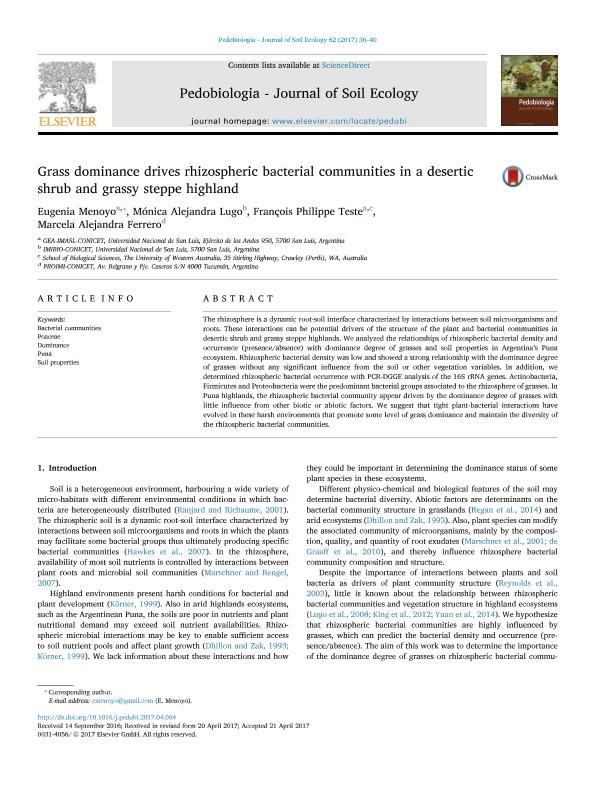Mostrar el registro sencillo del ítem
dc.contributor.author
Menoyo, Eugenia

dc.contributor.author
Lugo, Mónica Alejandra

dc.contributor.author
Teste, Francois

dc.contributor.author
Ferrero, Marcela Alejandra

dc.date.available
2018-12-27T20:33:35Z
dc.date.issued
2017-05
dc.identifier.citation
Menoyo, Eugenia; Lugo, Mónica Alejandra; Teste, Francois; Ferrero, Marcela Alejandra; Grass dominance drives rhizospheric bacterial communities in a desertic shrub and grassy steppe highland; Elsevier Gmbh; Pedobiologia; 62; 5-2017; 36-40
dc.identifier.issn
0031-4056
dc.identifier.uri
http://hdl.handle.net/11336/67120
dc.description.abstract
The rhizosphere is a dynamic root-soil interface characterized by interactions between soil microorganisms and roots. These interactions can be potential drivers of the structure of the plant and bacterial communities in desertic shrub and grassy steppe highlands. We analyzed the relationships of rhizospheric bacterial density and occurrence (presence/absence) with dominance degree of grasses and soil properties in Argentina's Puna ecosystem. Rhizospheric bacterial density was low and showed a strong relationship with the dominance degree of grasses without any significant influence from the soil or other vegetation variables. In addition, we determined rhizospheric bacterial occurrence with PCR-DGGE analysis of the 16S rRNA genes. Actinobacteria, Firmicutes and Proteobacteria were the predominant bacterial groups associated to the rhizosphere of grasses. In Puna highlands, the rhizospheric bacterial community appear driven by the dominance degree of grasses with little influence from other biotic or abiotic factors. We suggest that tight plant-bacterial interactions have evolved in these harsh environments that promote some level of grass dominance and maintain the diversity of the rhizospheric bacterial communities.
dc.format
application/pdf
dc.language.iso
eng
dc.publisher
Elsevier Gmbh

dc.rights
info:eu-repo/semantics/openAccess
dc.rights.uri
https://creativecommons.org/licenses/by-nc-sa/2.5/ar/
dc.subject
Bacterial Communities
dc.subject
Dominance
dc.subject
Poaceae
dc.subject
Puna
dc.subject
Soil Properties
dc.subject.classification
Otras Ciencias Biológicas

dc.subject.classification
Ciencias Biológicas

dc.subject.classification
CIENCIAS NATURALES Y EXACTAS

dc.title
Grass dominance drives rhizospheric bacterial communities in a desertic shrub and grassy steppe highland
dc.type
info:eu-repo/semantics/article
dc.type
info:ar-repo/semantics/artículo
dc.type
info:eu-repo/semantics/publishedVersion
dc.date.updated
2018-10-23T17:43:14Z
dc.journal.volume
62
dc.journal.pagination
36-40
dc.journal.pais
Alemania

dc.journal.ciudad
Berlín
dc.description.fil
Fil: Menoyo, Eugenia. Consejo Nacional de Investigaciones Científicas y Técnicas. Centro Científico Tecnológico Conicet - San Luis. Instituto de Matemática Aplicada de San Luis ; Argentina
dc.description.fil
Fil: Lugo, Mónica Alejandra. Consejo Nacional de Investigaciones Científicas y Técnicas. Centro Científico Tecnológico Conicet - San Luis. Instituto Multidisciplinario de Investigaciones Biológicas de San Luis. Universidad Nacional de San Luis. Facultad de Ciencias Físico Matemáticas y Naturales. Instituto Multidisciplinario de Investigaciones Biológicas de San Luis; Argentina
dc.description.fil
Fil: Teste, Francois. Consejo Nacional de Investigaciones Científicas y Técnicas. Centro Científico Tecnológico Conicet - San Luis. Instituto de Matemática Aplicada de San Luis ; Argentina. University of Western Australia; Australia
dc.description.fil
Fil: Ferrero, Marcela Alejandra. Consejo Nacional de Investigaciones Científicas y Técnicas. Centro Científico Tecnológico Conicet - Tucumán. Planta Piloto de Procesos Industriales Microbiológicos; Argentina
dc.journal.title
Pedobiologia

dc.relation.alternativeid
info:eu-repo/semantics/altIdentifier/url/https://www.sciencedirect.com/science/article/pii/S0031405616301226
dc.relation.alternativeid
info:eu-repo/semantics/altIdentifier/doi/https://doi.org/10.1016/j.pedobi.2017.04.004
Archivos asociados
